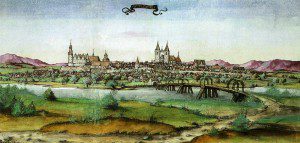
The Schlosskirche is on the left, while the two towers of the Stadtkirche are near the middle of the view.
(Click to enlarge. Click again
Wittenberg is a quiet, quaint little town — and especially so on Sundays like today.
But it was the center of one of the major revolutions in the history of Western Civilization, and there are more UNESCO World Heritage sites concentrated in a smaller area here than anywhere else on Planet Earth.
As I write, I’m about a hundred yards from Martin Luther’s house on the one side (maybe less), and perhaps fifty yards, on the other, from the house where his chief lieutenant, Philip Melanchthon, lived. A two or three hundred yards down the Collegienstrasse, on which our hotel and the Luther and Melanchthon houses sit, is the complex of buildings that once belonged to the pharmacist — and painter and visual chronicler of Luther and the Reformation — Lucas Cranach the Elder. Before you get to the Cranach pharmacy, though, you pass the original site of the University of Wittenberg, where Luther and Melanchthon and Giordano Bruno taught and where G. E. Lessing earned his master’s degree. (According to Shakespeare, Hamlet and his friend Horatio were also students in Wittenberg.) And across the Collegienstrasse from the original university location is a placard on a building indicating that someone by the name of Johann Faust, an astrologer and alchemist, lived there for roughly two years.
Just slightly further down the street is the Stadtkirche, or St. Marienkirche, which is known as “the Mother Church of the Reformation.” Dr. Luther preached repeatedly in the Stadtkirche, and it was in the Stadtkirche that the liturgy of the mass was first said in a vernacular language rather than in Latin — in his case, it was said in German — and that both wine and wafer were given to ordinary lay members of the congregation.
Finally, just two or three hundred yards, if that, past the Stadtkirche, is the Schlosskirche or Palace Church. Luther is buried there. But in 1517 — the five hundredth anniversary is just two years away — it was on the door of the Schosskirche that Luther nailed his ninety-five theses, challenging the sale of indulgences, and thus launched the Reformation. (Or he didn’t. Some claim that he never did any such thing.)
But he certainly burnt the papal bull issued by Pope Leo on 10 December 1520, which threatened him with excommunication. He did so about three hundreds yards or less from my hotel room, in the other direction.
What a place!
I think it would be great fun to bring a Mormon tour group here, and to some of the other Reformation sites clustered around the area.
Posted from Wittenberg, Germany










